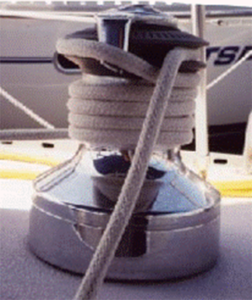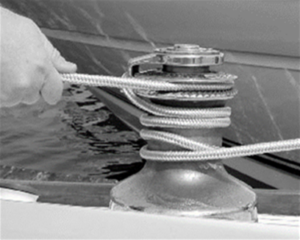Using a Winch with Line
Using a Winch with Line
Hand winches are mechanical devices designed to multiply your pulling force. They are normally found on larger sailboats and used for halyards and sheets. The principal parts are the drum, the cranking handle, the internal gearing, and the ratchet to prevent back-turning. Part of the force multiplying comes from the ratio of the crank-handle length to the drum radius. An 8-inch handle with a 2-inch drum radius gives you a 4:1 advantage. The other part of the force multiplying comes from the winch gearing. Some winches are geared for two or even three speeds depending on which way you turn the crank handle. The drum always turns in the same direction.
To make a winch work for you, you must do two things: wrap about 3 or 4 turns of line on the winch drum (usually clockwise as viewed from above) and “tail” (keep tension on) the bitter end. The number of turns will depend on the line diameter, winch size, and load. To pay out line from a winch, reduce the tailing tension until the line slips backward around the drum. Some winches have a “self-tailing” mechanism. This mechanism must be disabled to release the line. As with any high- tech gadget, practice with the winch before you have to rely on it to work for you. The line must be released from this mechanism to play out the line. Practice with the winch before using it under load. Be careful to avoid having fingers drawn into the coils around the winch. The feed to the winch drum must be from the bottom up at an angle. If you feed the line level or at a downward angle, it will jam. If you make a mistake, you will need to use a Rolling Hitch on the line under load to ease the tension so you can untie the jam.


